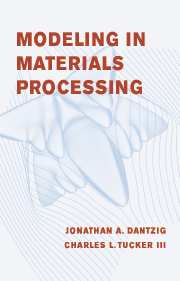Book contents
- Frontmatter
- Contents
- Preface
- Principal Nomenclature
- 1 Introduction
- 2 Governing Equations
- 3 Scaling and Model Simplification
- 4 Heat Conduction and Materials Processing
- 5 Isothermal Newtonian Fluid Flow
- 6 Non-Newtonian Fluid Flow
- 7 Heat Transfer with Fluid Flow
- 8 Mass Transfer and Solidification Microstructures
- A Mathematical Background
- B Balance and Kinematic Equations
- Bibliography
- Index
A - Mathematical Background
Published online by Cambridge University Press: 05 June 2012
- Frontmatter
- Contents
- Preface
- Principal Nomenclature
- 1 Introduction
- 2 Governing Equations
- 3 Scaling and Model Simplification
- 4 Heat Conduction and Materials Processing
- 5 Isothermal Newtonian Fluid Flow
- 6 Non-Newtonian Fluid Flow
- 7 Heat Transfer with Fluid Flow
- 8 Mass Transfer and Solidification Microstructures
- A Mathematical Background
- B Balance and Kinematic Equations
- Bibliography
- Index
Summary
This appendix summarizes some important mathematical background. We first cover vector and tensor algebra and the relationship between different styles of notation. Other topics include the divergence theorem, the curvature of curves and surfaces, and the Gaussian error function. The material is intended primarily for reference purposes, so no derivations or proofs are provided. Readers desiring more background can consult the bibliography at the end of this appendix.
In this appendix the symbols u, v, and w represent arbitrary vectors, and σ and τ represent arbitrary tensors.
SCALARS, VECTORS, AND TENSORS: DEFINITIONS AND NOTATION
SCALARS AND VECTORS
A scalar is a quantity that has magnitude but no direction. Physical quantities that are scalars include temperature, pressure, and density. Scalar quantities are denoted by lightface italic symbols: T, p, ρ.
A vector is a quantity having both magnitude and direction. We frequently visualize a vector as an arrow in space: the direction of the arrow gives the direction of the vector, and the length of the arrow gives the vector's magnitude. Vector quantities include velocity, surface traction, and heat flux.
This text uses several different notations for vectors. In one of these, called Gibbs notation, the vector is denoted by a boldface letter: v, t, q. The bold letter represents the entire vector, and this notation is not tied to any particular choice of coordinate system. A convenient notation for the blackboard or handwritten work is to underline letters that represent vectors.
Information
- Type
- Chapter
- Information
- Modeling in Materials Processing , pp. 327 - 347Publisher: Cambridge University PressPrint publication year: 2001
